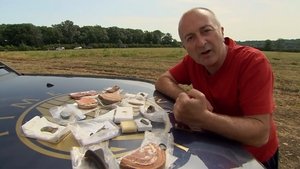Over the years, farmers working the fields have found large quantities of worked stone, medieval tiles and even two shelly limestone columns, adding credence to the local belief that a medieval chapel once stood here. Time Team visits the cold and windswept Chapel Head, in the Cambridgeshire Fens, to see if a medieval chapel did once stand there.
The Team visits Lincoln's Inn, London where they have been asked to investigate the remains of a 13th-century palace that belonged to Henry III's Lord Chancellor. There were only a few areas within Lincoln's Inn where any excavation could take place. As well as it not being possible to dig under the other historic buildings, a huge London plane tree precluded any excavation that would threaten its root system.

Legend has it that Jesus Christ himself played on the pebble beach at Looe Island (also known as St George's Island), about one mile off the south Cornwall coast near Looe. It is a story that probably originated when the island was being established as a place of pilgrimage to rival St Michael's Mount further to the southwest.

The Team are invited to investigate a Bedfordshire field by a group of amateur archaeologists who have found countless pieces of Roman pottery, coins and building material over the years. In a field next to a science park in Colworth, Bedfordshire, a group of amateur archaeologists have turned up a huge collection of material dating back almost 2,000 years.
The Team are in Radcot, Oxfordshire, where they hope to uncover a long-lost fortress built in the 12th century during one of the bloodiest episodes of English history. The tiny hamlet of Radcot in Oxfordshire stands on a strategic crossing on the river Thames. Competing armies have fought over control of the crossing from at least medieval times through to the English Civil War.
Time Team gets a once-in-a-lifetime opportunity to dig in the hallowed grounds of Salisbury Cathedral – in Phil Harding's home town. In 2008, Salisbury marked the 750th anniversary of the consecration of its cathedral. At the end of September the city played host to Time Team, who had been given the unique opportunity to investigate some of the lost architectural treasures of this magnificent building.
Time Team visits the Yorkshire Dales to investigate the Risehill camp settlement, inhabited by the Victorian railway navvies during the construction of the Settle-to-Carlisle railway. On a wind- and rain-swept Yorkshire moor – 'the most exposed site Time Team has ever dug on,' according to Tony Robinson – lie the remains of a settlement built by a tough, nomadic community that existed on the very edge of society.

Caerwent is the best-preserved Roman town in Britain. Laid out on a grid pattern, it has 20 blocks within its walls, which still stand at heights of up to five metres in places. Previous excavations have uncovered roads, temples, shops, baths, houses and villas, as well as the forum and basilica, the town's political centre.

Time Team has never found a Roman temple. But a 30-year-old photograph clearly shows double square cropmarks in a field. Surely this time they will strike lucky? The trouble is, the site may have suffered plough damage. Francis takes charge. Though initial excavations are encouraging, John and Stewart are puzzled by a geophysical anomaly. Including a tessellated pavement and a coin hoard, a picture gradually emerges of not one but four temples - in fact a whole complex of buildings. It proves to be one of the most important excavations in Time Team history.